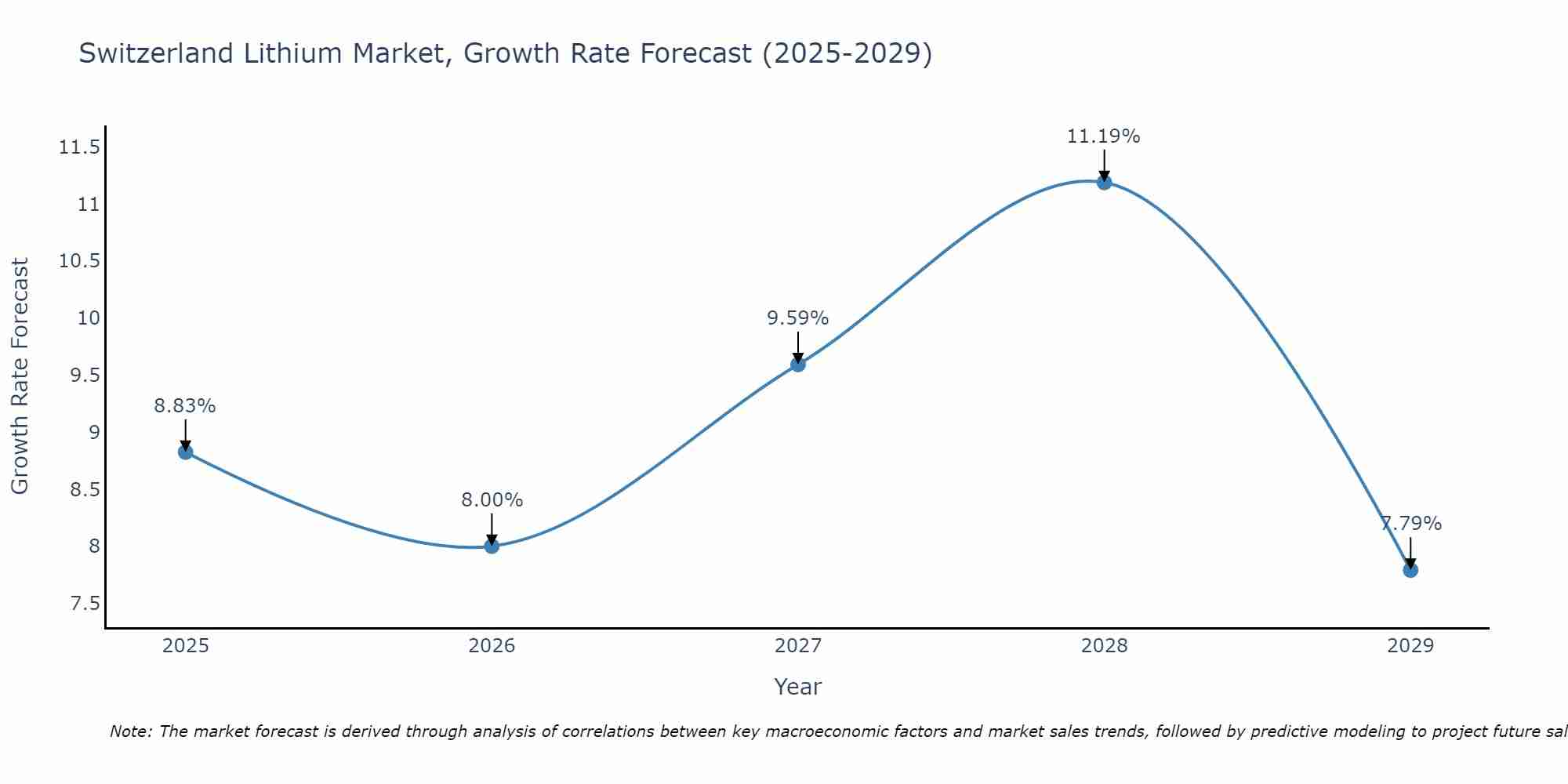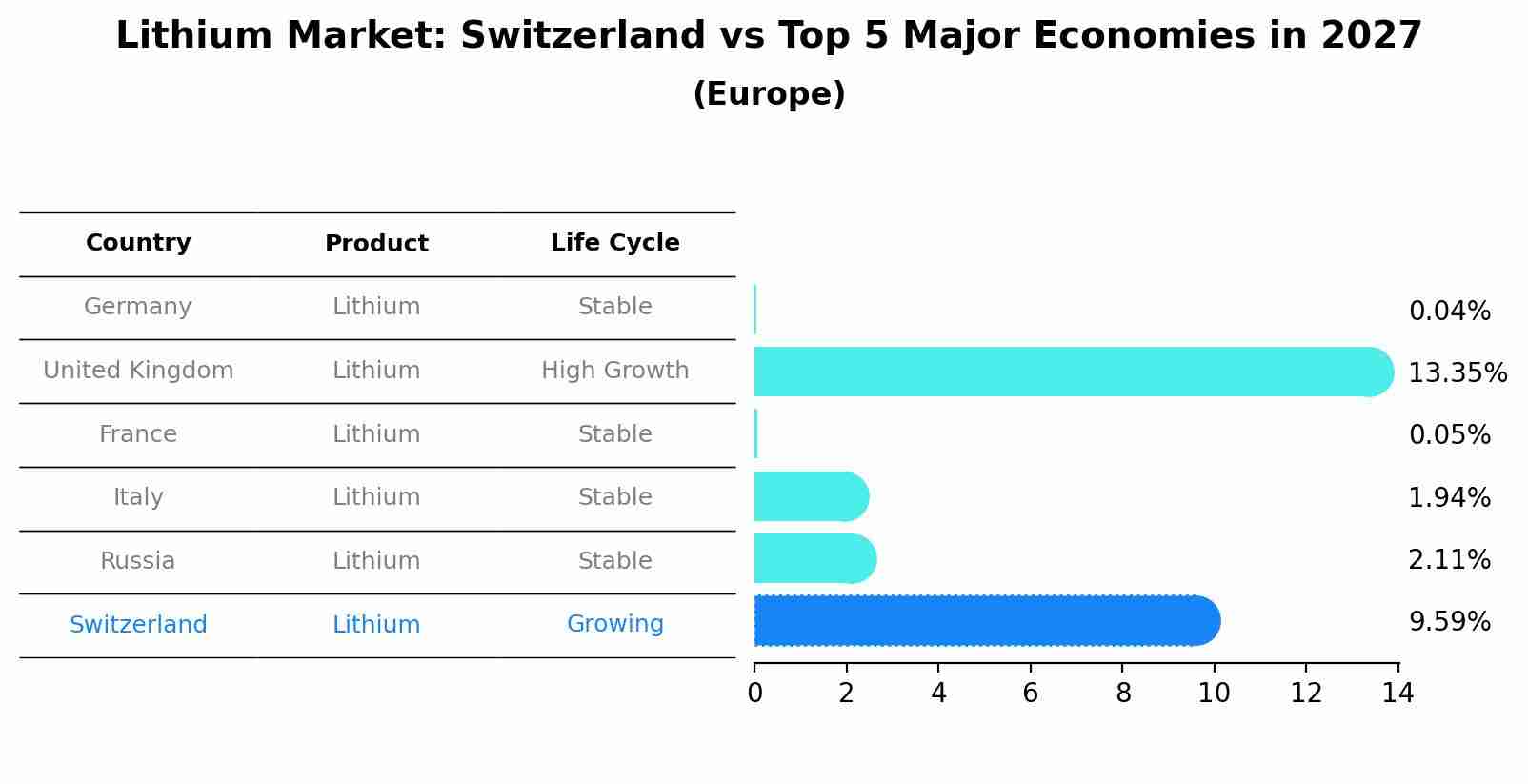Switzerland Lithium Market (2025-2031) | Analysis, Share, Forecast, Segmentation, Companies, Outlook, Size, Industry, Growth, Value, Trends & Revenue
| Product Code: ETC4896371 | Publication Date: Nov 2023 | Updated Date: Aug 2025 | Product Type: Market Research Report | |
| Publisher: 6Wresearch | Author: Sachin Kumar Rai | No. of Pages: 60 | No. of Figures: 30 | No. of Tables: 5 |
Switzerland Lithium Market Size Growth Rate
The Switzerland Lithium Market is projected to witness mixed growth rate patterns during 2025 to 2029. Growth accelerates to 11.19% in 2028, following an initial rate of 8.83%, before easing to 7.79% at the end of the period.

Lithium Market: Switzerland vs Top 5 Major Economies in 2027 (Europe)
The Lithium market in Switzerland is projected to grow at a growing growth rate of 9.59% by 2027, highlighting the country's increasing focus on advanced technologies within the Europe region, where Germany holds the dominant position, followed closely by United Kingdom, France, Italy and Russia, shaping overall regional demand.

Switzerland Lithium Market Overview
Switzerlands lithium market is evolving, driven by the rising demand for lithium in battery manufacturing, particularly for electric vehicles and renewable energy storage. The country is actively participating in the global lithium supply chain, with a focus on sustainable extraction, recycling, and refining processes. The market is characterized by strong research and development efforts aimed at improving battery performance, efficiency, and environmental impact.
Drivers of the market
The overall lithium market in Switzerland is propelled by the increasing applications of lithium in battery technology, especially for electric vehicles and energy storage systems. The rapid expansion of the electric vehicle market and the focus on renewable energy sources significantly enhance the demand for lithium. Furthermore, technological advancements and the growing emphasis on sustainability contribute to the market`s robust growth.
Challenges of the market
The broader lithium market faces challenges related to supply and demand dynamics influenced by global economic trends. The rapid growth in electric vehicle sales and renewable energy storage systems has created a surge in lithium demand, but supply constraints from mining operations can lead to volatility in prices. Moreover, environmental concerns surrounding lithium extraction, such as water usage and habitat disruption, necessitate compliance with increasingly stringent regulations. Companies must balance production capabilities with sustainable practices to maintain their market position.
Government Policy of the market
The overall lithium market in Switzerland benefits from robust governmental support for the transition to renewable energy and electric mobility. Policies aimed at increasing the use of lithium in energy storage systems align with Switzerlands commitment to sustainability and carbon neutrality. The government invests in infrastructure for lithium processing and battery recycling, promoting a circular economy. Collaborative efforts with international partners enhance Switzerland`s competitive edge in the global lithium market, ensuring a stable supply chain for critical materials.
Key Highlights of the Report:
- Switzerland Lithium Market Outlook
- Market Size of Switzerland Lithium Market, 2024
- Forecast of Switzerland Lithium Market, 2031
- Historical Data and Forecast of Switzerland Lithium Revenues & Volume for the Period 2021-2031
- Switzerland Lithium Market Trend Evolution
- Switzerland Lithium Market Drivers and Challenges
- Switzerland Lithium Price Trends
- Switzerland Lithium Porter`s Five Forces
- Switzerland Lithium Industry Life Cycle
- Historical Data and Forecast of Switzerland Lithium Market Revenues & Volume By Product for the Period 2021-2031
- Historical Data and Forecast of Switzerland Lithium Market Revenues & Volume By Carbonates for the Period 2021-2031
- Historical Data and Forecast of Switzerland Lithium Market Revenues & Volume By Hydroxide for the Period 2021-2031
- Historical Data and Forecast of Switzerland Lithium Market Revenues & Volume By Others for the Period 2021-2031
- Historical Data and Forecast of Switzerland Lithium Market Revenues & Volume By Application for the Period 2021-2031
- Historical Data and Forecast of Switzerland Lithium Market Revenues & Volume By Automotive for the Period 2021-2031
- Historical Data and Forecast of Switzerland Lithium Market Revenues & Volume By Consumer Electronics for the Period 2021-2031
- Historical Data and Forecast of Switzerland Lithium Market Revenues & Volume By Grid Storage for the Period 2021-2031
- Historical Data and Forecast of Switzerland Lithium Market Revenues & Volume By Glass & Ceramics for the Period 2021-2031
- Historical Data and Forecast of Switzerland Lithium Market Revenues & Volume By Others for the Period 2021-2031
- Switzerland Lithium Import Export Trade Statistics
- Market Opportunity Assessment By Product
- Market Opportunity Assessment By Application
- Switzerland Lithium Top Companies Market Share
- Switzerland Lithium Competitive Benchmarking By Technical and Operational Parameters
- Switzerland Lithium Company Profiles
- Switzerland Lithium Key Strategic Recommendations
Frequently Asked Questions About the Market Study (FAQs):
1 Executive Summary |
2 Introduction |
2.1 Key Highlights of the Report |
2.2 Report Description |
2.3 Market Scope & Segmentation |
2.4 Research Methodology |
2.5 Assumptions |
3 Switzerland Lithium Market Overview |
3.1 Switzerland Country Macro Economic Indicators |
3.2 Switzerland Lithium Market Revenues & Volume, 2021 & 2031F |
3.3 Switzerland Lithium Market - Industry Life Cycle |
3.4 Switzerland Lithium Market - Porter's Five Forces |
3.5 Switzerland Lithium Market Revenues & Volume Share, By Product, 2021 & 2031F |
3.6 Switzerland Lithium Market Revenues & Volume Share, By Application, 2021 & 2031F |
4 Switzerland Lithium Market Dynamics |
4.1 Impact Analysis |
4.2 Market Drivers |
4.2.1 Increasing demand for lithium-ion batteries in electric vehicles |
4.2.2 Growing focus on renewable energy storage solutions |
4.2.3 Technological advancements in lithium extraction and processing |
4.3 Market Restraints |
4.3.1 High production costs associated with lithium mining and processing |
4.3.2 Environmental concerns related to lithium extraction |
4.3.3 Competition from other battery technologies like solid-state batteries |
5 Switzerland Lithium Market Trends |
6 Switzerland Lithium Market Segmentations |
6.1 Switzerland Lithium Market, By Product |
6.1.1 Overview and Analysis |
6.1.2 Switzerland Lithium Market Revenues & Volume, By Carbonates, 2021-2031F |
6.1.3 Switzerland Lithium Market Revenues & Volume, By Hydroxide, 2021-2031F |
6.1.4 Switzerland Lithium Market Revenues & Volume, By Others, 2021-2031F |
6.2 Switzerland Lithium Market, By Application |
6.2.1 Overview and Analysis |
6.2.2 Switzerland Lithium Market Revenues & Volume, By Automotive, 2021-2031F |
6.2.3 Switzerland Lithium Market Revenues & Volume, By Consumer Electronics, 2021-2031F |
6.2.4 Switzerland Lithium Market Revenues & Volume, By Grid Storage, 2021-2031F |
6.2.5 Switzerland Lithium Market Revenues & Volume, By Glass & Ceramics, 2021-2031F |
6.2.6 Switzerland Lithium Market Revenues & Volume, By Others, 2021-2031F |
7 Switzerland Lithium Market Import-Export Trade Statistics |
7.1 Switzerland Lithium Market Export to Major Countries |
7.2 Switzerland Lithium Market Imports from Major Countries |
8 Switzerland Lithium Market Key Performance Indicators |
8.1 Average selling price of lithium in Switzerland |
8.2 Number of electric vehicle registrations in Switzerland |
8.3 Investment in lithium mining and processing infrastructure |
9 Switzerland Lithium Market - Opportunity Assessment |
9.1 Switzerland Lithium Market Opportunity Assessment, By Product, 2021 & 2031F |
9.2 Switzerland Lithium Market Opportunity Assessment, By Application, 2021 & 2031F |
10 Switzerland Lithium Market - Competitive Landscape |
10.1 Switzerland Lithium Market Revenue Share, By Companies, 2024 |
10.2 Switzerland Lithium Market Competitive Benchmarking, By Operating and Technical Parameters |
11 Company Profiles |
12 Recommendations | 13 Disclaimer |
- Single User License$ 1,995
- Department License$ 2,400
- Site License$ 3,120
- Global License$ 3,795
Search
Related Reports
- Portugal Electronic Document Management Market (2025-2031) | Strategy, Consumer Insights, Analysis, Investment Trends, Opportunities, Growth, Size, Share, Industry, Revenue, Segments, Value, Segmentation, Supply, Forecast, Restraints, Outlook, Competition, Drivers, Trends, Demand, Pricing Analysis, Competitive, Strategic Insights, Companies, Challenges
- France Electronic Document Management Market (2025-2031) | Strategy, Consumer Insights, Analysis, Investment Trends, Opportunities, Growth, Size, Share, Industry, Revenue, Segments, Value, Segmentation, Supply, Forecast, Restraints, Outlook, Competition, Drivers, Trends, Demand, Pricing Analysis, Competitive, Strategic Insights, Companies, Challenges
- Portugal Occupational Health & Safety Services Market (2025-2031) | Strategy, Consumer Insights, Analysis, Investment Trends, Opportunities, Growth, Size, Share, Industry, Revenue, Segments, Value, Segmentation, Supply, Forecast, Restraints, Outlook, Competition, Drivers, Trends, Demand, Pricing Analysis, Competitive, Strategic Insights, Companies, Challenges
- Netherlands Occupational Health and Safety Services Market (2025-2031) | Strategy, Consumer Insights, Analysis, Investment Trends, Opportunities, Growth, Size, Share, Industry, Revenue, Segments, Value, Segmentation, Supply, Forecast, Restraints, Outlook, Competition, Drivers, Trends, Demand, Pricing Analysis, Competitive, Strategic Insights, Companies, Challenges
- Belgium and Luxembourg Facility Management Market (2025-2031) | Strategy, Consumer Insights, Analysis, Investment Trends, Opportunities, Growth, Size, Share, Industry, Revenue, Segments, Value, Segmentation, Supply, Forecast, Restraints, Outlook, Competition, Drivers, Trends, Demand, Pricing Analysis, Competitive, Strategic Insights, Companies, Challenges
- Russia Women Intimate Apparel Market (2025-2031) | Strategy, Consumer Insights, Analysis, Investment Trends, Opportunities, Growth, Size, Share, Industry, Revenue, Segments, Value, Segmentation, Supply, Forecast, Restraints, Outlook, Competition, Drivers, Trends, Demand, Pricing Analysis, Competitive, Strategic Insights, Companies, Challenges
- Africa Chocolate Market (2025-2031) | Size, Share, Trends, Growth, Revenue, Analysis, Forecast, industry & Outlook
- Global Hydroxychloroquine And Chloroquine Market (2025-2031) | Industry, Trends, Size, Outlook, Growth, Value, Companies, Revenue, Analysis, Share, Forecast
- Saudi Arabia Plant Maintenance Market (2025-2031) | Industry, Size, Growth, Revenue, Value, Companies, Forecast, Analysis, Share & Trends
- Taiwan Electric Truck Market (2025-2031) | Outlook, Industry, Revenue, Size, Forecast, Growth, Analysis, Share, Companies, Value & Trends
Industry Events and Analyst Meet
Our Clients
Whitepaper
- Middle East & Africa Commercial Security Market Click here to view more.
- Middle East & Africa Fire Safety Systems & Equipment Market Click here to view more.
- GCC Drone Market Click here to view more.
- Middle East Lighting Fixture Market Click here to view more.
- GCC Physical & Perimeter Security Market Click here to view more.
6WResearch In News
- Doha a strategic location for EV manufacturing hub: IPA Qatar
- Demand for luxury TVs surging in the GCC, says Samsung
- Empowering Growth: The Thriving Journey of Bangladesh’s Cable Industry
- Demand for luxury TVs surging in the GCC, says Samsung
- Video call with a traditional healer? Once unthinkable, it’s now common in South Africa
- Intelligent Buildings To Smooth GCC’s Path To Net Zero













